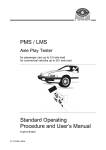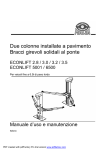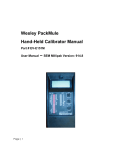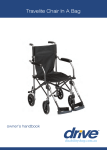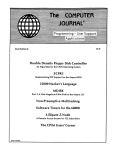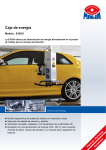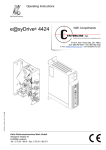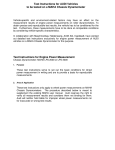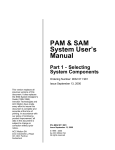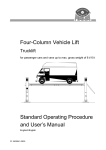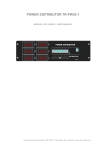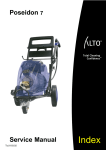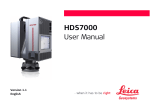Download Roller Dynamometer LPS 23/2 Standard Operating
Transcript
Roller Dynamometer LPS 23/2 for performance testing for mopeds and motorcycles up to 10 kW Standard Operating Procedures and User’s Manual English D1 0702BA1-GB01 LPS 23/2 Current Version Status Version 1 of the Operating Manual dated 15.10.1998 D1 0702BA1-GB01 © 1997-1998 MAHA GmbH & Co. KG All rights reserved. Any reproductions this operating manual, partial or complete, is only allowed with prior consent of MAHA GmbH & Co. KG. All rights reserved in cases of patent granting or registration of design. The contents of this verison have been checked with great care. However, errors cannot be fully excluded. Please contact MAHA should yo find errors of any kind so that the documentation can be corrected. These instructions are intended for users with previous technical knowledge in the field of vehicle testing technology. These instruction should be kept for future reference! Manufacturer MAHA Maschinenbau Haldenwang GmbH & Co. KG Hoyen 20 D-87490 Haldenwang/Allgäu Telephone: 08374 / 585-0 Telefax : 08374/ 585-499 Internet : http://www.maha.de e-mail : [email protected] Service MAHA Maschinenbau Haldenwang GmbH & Co. KG - Service Department Hoyen 20 D-87490 Haldenwang/Allgäu Hotline : 08374 / 585-145 Service : 08374 / 585- 110 bis 113, -115 Telefax : 08374/ 585-491 II D1 0702BA1-GB01 LPS 23/2 Table of Contents 1 Safety 1.1 1.2 1.3 1.4 1.5 1.6 Introduction ..................................................................................................................1.1 MAHA’s Responsibility..................................................................................................1.1 Safety Guidelines.........................................................................................................1.2 Official Safety Regulations ...........................................................................................1.3 Combining the Performance Tester LPS 23/2 with Accessories ...................................1.3 Replacing Parts............................................................................................................1.3 2 Description 2.1 2.2 2.3 2.3.1 2.3.2 2.3.3 Introduction ..................................................................................................................2.1 Range of Application ....................................................................................................2.2 Technical Specification ................................................................................................2.2 Physical Data...............................................................................................................2.2 Electrical data ..............................................................................................................2.3 Noise Emission ............................................................................................................2.3 3 Operations 3.1 3.1.1 3.1.2 3.2 3.2.1 3.2.2 3.3 3.3.1 3.3.2 3.3.3 3.3.4 3.4 3.4.1 3.4.2 3.4.3 Principles of the Driving Resistance Simulation............................................................3.1 Stationary Driving Resistance ......................................................................................3.1 Acceleration Resistance ..............................................................................................3.3 Setting the Driving resistance.......................................................................................3.3 Stationary Driving Resistance ......................................................................................3.3 Acceleration Resistance ..............................................................................................3.3 Speed Measurement ....................................................................................................3.4 Setting the Brake Resistance.......................................................................................3.4 Test Vehicle .................................................................................................................3.4 Holding Device .............................................................................................................3.4 Conducting a Speed Measurement ...............................................................................3.4 Performance Measurement ..........................................................................................3.5 Determination of the Brake Performance......................................................................3.5 Determination of the Engine Performance ....................................................................3.6 Important Factors and Errors during the Speed Measurement ......................................3.6 D1 0702BA1-GB01 III LPS 23/2 4 Calibration 4.1 4.2 4.2.1 4.2.2 Mechanical Setting.......................................................................................................4.1 Electronic Setting .........................................................................................................4.1 Setting of the Electronic Components on PCB MAH-LMF-LPS 23/2 .............................4.2 Adjustments..................................................................................................................4.3 5 Maintenance and Warranty 5.1 5.2 5.2.1 5.2.2 Maintenance ................................................................................................................5.1 Warranty ......................................................................................................................5.1 Warranty Conditions ....................................................................................................5.1 Warranty Exclusion Clause ..........................................................................................5.1 IV D1 0702BA1-GB01 LPS 23/2 Safety 1 Safety 1.1 Introduction Chapter 1 describes safety aspects which should always be carefully observed when operating the Performance Tester LPS 23/2. Safety information is provided to warn about dangerous situations and help prevent damage to equipment and injury to persons. The operating manual for the Performance Tester LPS 23/2 must be read thoroughly and completely by the operator before commissioning. MAHA will not accept and is not liable for any claims for damage or service costs incurred due to non-compliance with these operating instructions. Customer service calls and costs for unnecessary return shipments will be invoiced to the customer when the operating manual instructions have not been complied with. Carefully observe all federal and international safety guidelines for work place protection. Every user is responsible for observing all regulations which apply to his workplace and is obliged to integrate any new regulations that may be initiated. The operating manual should always be conveniently stored to be readily available at all times. 1.2 MAHA’s Responsibility MAHA Maschinenbau Haldenwang GmbH & Co KG is only responsible for the safety, reliability and performance of the Performance Tester LPS 23/2: D1 0702BA1-GB01 - the equipment is operated using the valid operating manual and these instructions are correctly adhered to, - the electrical installation in the room in which the Performance Tester LPS 23/2 is operated corresponds with national standards. 1.1 Safety 1.3 LPS 23/2 Safety Guidelines The following guidelines must be thorougly read and adhered to! 1.2 - The Accident Prevention Regulations of the country in which the equipment is being operated apply. - The Performance Tester LPS 23/2 may only be commissioned by MAHA service technicians or those authorized by MAHA as service partners. - The Performance Tester LPS 23/2 may not be installed or operated in explosion endangered rooms or wash halls. Standard performance testers have no EX-protection. - All electrical parts of the Performance Tester LPS 23/2 must be protected from moisture and humidity. - The Performance Tester LPS 23/2 may only be used and operated for its intended purpose! - The Performance Tester LPS 23/2 may only be operating within its stated performance limits. - The Performance Tester LPS 23/2 may only be operated by trained, authorized personnel. - The Performance Tester LPS 23/2 must be switched off when not in use and the main switch secured against tampering with a padlock. - Running vehicle engines represent potential carbon monoxide poisoning. The operator/owner is responsible for providing sufficient air ventilation. - Avoid unnecessary strain on vehicle and test stand. Drive the vehicle slowly onto the test stand. - Pay attention that the vehicle has sufficient ground clearance. Damage to low-lying parts are not covered by the warranty. - Avoid tire damage! Routinely check that the bolts on the cover plates are tight. - Never clean the lifting platform with high-pressure cleaners or steam cleaners! - Maintenance or repair work on the Performance Tester LPS 23/2 may only be done by MAHA service technicians or authorized service partners. Non-compliance invalidates the warranty. Unskilled work done on the machinery can be life threatening! D1 0702BA1-GB01 LPS 23/2 1.4 Safety Official Safety Regulations The Performance Tester LPS 23/2 meets the safety demands of the following guidelines: 1.5 - 89/392/EWG in connection with 91/368/EWG and 93/44/EWG EGMaschinery guidelines - 73/23/EWG EG- Low Voltage guidelines - 89/336/EWG EG- guidelines regarding electro-magnetic tolerance Combining the Performance Tester LPS 23/2 with Accessories The Performance Tester LPS 23/2 may only be operated with accessories which MAHA has offered, approved and/or permitted. This applies especially for every accessory with electrical, electronic and/or mechanical connection to the Performance Tester LPS 23/2. 1.6 Replacing Parts Only original MAHA spare parts may be used to guarantee the reliable functioning of the MAHA Performance Tester LPS 23/2 and thereby the safety of the equipment. Original MAHA spare parts are manufactured under the highest quality standards for material and production procedures. Warranty coverage is invalid if any other kind of spare parts are used! D1 0702BA1-GB01 1.3 Safety 1.4 LPS 23/2 D1 0702BA1-GB01 LPS 23/2 Description 2 Description 2.1 Introduction The Performance Tester LPS 23/2 consists in its basic version of the following components: · indication unit · roller set · front-wheel platform incl. holding device · ramp Based on the eddy-current brake principle, a certain brake force (brake performance) that depends on the position of the selector switch, is generated via the front rollers. An inductive impulse sensor on the back drum facilitates the speed and distance measurement. Speeds up to 100 km/h and brake forces up to 10 kW can be displayed on the indication unit.The stationary driving resistance (brake resistance) can be set with a rotary switch on the display cabinet depending on the type of vehicle and on the tire size. The acceleration resistance is simulated via a variably adjustable potentiometer. Indication unit: performance display speed display main switch potentiometer for acceleration resistance cable remote control rotary switch for driving resistance For the test, the vehicle should be wheeled over the ramps onto the test stand. Once the front tire of the vehicle is positioned centered on the roller set the front tire can be clamped into the holding device. The desired test program can now be selected on the cable remote control. For a speed measurement (driving resistance) select position F, for a performance test select position P. D1 0702BA1-GB01 2.1 Description 2.2 LPS 23/2 Range of Application The roller performance tester permits: - determination of the maximum speed - performance testing - acceleration simulation under load For the driving noise emission test a special measuring equipment and an appropriate testing ground (50m x 50m, sourrounding noises <55dB) are required. NOTE It is recommended that the Performance Tester LPS 23/2 not be used for mopeds with a tire size less than 10’’ (e.g. Mini-Bike). ATTENTION During tests performed on the roller dynamometer it is recommended to use a cooling fan to protect the engine against overheating. 2.3 Technical Specification 2.3.1 Physical Data Roller set Construction: self supporting, stainless steel Dimensions (L x W x H): 690 x 510 x 360 mm Roller length: 200 mm Roller diameter: 200 mm Roller axle separation: 200 - 400 mm Smallest wheel ∅ for testing: 12’’ Indication unit 2.2 Dimensions (Hx W x D): 1400 x 400 x 250 mm Speed indication: 0 - 120 km/h Performance indication: 0 - 10 kW Height of digital display: 25,4 mm Indication accuracy: ± 2% from measurement range end value D1 0702BA1-GB01 LPS 23/2 2.3.2 2.3.3 Description Electrical data Power connection values: 220 V , 50 Hz Fuse: 16 A slow Performance of eddy current brake: 10 kW Noise Emission The noise emission value created when the tester is in operation is less than 70 dB(A) in the work area of the operational personnel. D1 0702BA1-GB01 2.3 Description 2.4 LPS 23/2 D1 0702BA1-GB01 LPS 23/2 Operations 3 Operations 3.1 Principles of the Driving Resistance Simulation 3.1.1 Stationary Driving Resistance The fundamental basis for the determination of setting values used for the driving resistance simulation are coast down trials performed on the road (driving trials). The coefficients for the stationary operating status are calculated as follows: FF = A + Bv + Cv 2 FF = driving resistance during driving trial v = speed A = coefficient for roller resistance B = coefficient for roller resistance C = coefficient for roller resistance Tab. 3-1 Driving resistance coefficients for mopeds, mokiks and light motorcycles as a function of the tire diameter: Vehicle type Moped (v ≤ 25 km/h) Construction type Tire ∅ Driving resistance coefficient A B C road-version > 10’’ 9, 222 0, 592 0,0165 Mini-Bike ≤ 10’’ -- -- -- Mokick road-version > 10’’ 20,696 0,318 0,020 Light motorcycle (v ≤ 25 km/h) Mini-Bike, Scooter ≤ 10’’ 27,846 0,600 0,017 D1 0702BA1-GB01 3.1 Operations LPS 23/2 On the test stand the simulated driving resistance results from the roller resistance of the test stand rollers FRP and the brake force Fbrake generated from the eddy-current brake. For an exact simulation of the driving resistance (FF) on the performance tester, the roller resistance has to be determined on the test stand rollers (see fig. 3.2.) FRP = ARP + BRPv + CRPv2 FF = Fbrake + FRP Fbrake = A - ARP + (B - BRP) v + (C - CRP) v2 Fig. 3-2 Determination of the brake force required for the maximum speed measurement on the dynamometer: driving resistance of a moped 25 brake resistance on the roller brake resistance on the roller with driver brake resistance on the roller without driver The setting values for the reference point at v = 60 km/h are calculated from the brake performance as follows: Pbrake = [A - ARP + (B - BRP) v + (C - CRP) v2] v 3.2 D1 0702BA1-GB01 LPS 23/2 Operations As the roller resistance with driver is too high in comparison with the driving resistance a negative brake resistance must be simulated for the moped 25 that cannot be realized with the functioning principle of the performance tester. Therefore the moped 25 must always be tested without a driver, as the roller resistance for the simulated brake performance is calculated without the load of the driver. 3.1.2 Acceleration Resistance In order to simulate the acceleration under load (dv/dt ≠ 0) the proportional masses from translation and rotation to be simulated on the dynamometer must be set based on the following approximation formula: FB(P) = me x dv/dt me = mvehicle + mdriver + mVR - mPR In comparison to trials on the road it has to be considered that the front tire of the test vehicle (rotational mass mVR ≈ 6kg) is at a standstill and the rotary inertia of the test stand rollers counteracts to the acceleration process. 3.2 Setting the Driving Resistance 3.2.1 Stationary Driving Resistance The brake resistance or the brake performance is set with the rotary switch on the indication unit after determination of type, construction and the tire size of the test vehicle (see fig. 3.2.). 3.2.2 Acceleration Resistance In order to perform an acceleration simulation on the dynamometer, the acceleration resistance must be set on the potentiometer considering the effective masses based on the following calculation: me = mvehicle + mdriver + (6 - 23) kg (also see tab. 3.1) D1 0702BA1-GB01 3.3 Operations LPS 23/2 3.3 Speed Measurement 3.3.1 Setting the Brake Resistance The brake resistance is set with the rotary switch on the indication unit in accordance with the test vehicle. On the remote control the position F (driving resistance) must be selected. 3.3.2 Test Vehicle The rear tire pressure of the test vehicle must be set according to the specifications of the tire- or vehicle manufacturer (approximate values: 2 - 2,5 bar). If the tire pressure is not within the given tolerance range, the pressure must be adjusted to the correct value. 3.3.3 Holding Device The vehicle must be positioned straight and centered on the test stand. The rear tire of the vehicle must also be centrally positioned on the roller set. ATTENTION Do start a test if the vehicle does not keep in lane and the safety distance to the roller cover is too small! 3.3.4 Conducting a Speed Measurement The speed measurement can be startet if: ATTENTION 3.4 - the vehicle runs centered on the test stand rollers - the front roller rotate without clearly recognizable slip (brake resistance) - the operating temperature of the vehicle motor has been reached During tests performed on the roller dynamometer it is highly recommended to use a cooling fan to protect the engine against overheating! D1 0702BA1-GB01 LPS 23/2 Operations The speed measurement for mopeds 25 must always be conducted without a driver. Mokicks and light motorcycles are tested with driver. Conducting the test: 3.4 1 Accelerate the vehicle up to the maximum speed and maintain the speed approximately 2 - 3 minutes until the RPM of the engine has been stabilized. The speed is displayed on the indication unit. 2 Repeat the test 3 times. Once 3 individual tests have been conducted, the arithmetic mean value of the speed values has to be calculated. Performance Measurement The performance measurement is conducted without the simulation of the driving resistance, therefore position P (without brake resistance) must be selected on the remote control. For the determination of the nominal RPM a RPM-sensor must be connected. 3.4.1 Determination of the Brake Performance The brake performance is determined without a driver on the vehicle. Conducting the test: D1 0702BA1-GB01 1 Set rotary switch on the remote control to position P and the speed selector switch to a low value. 2 Accelerate the vehicle in the highest gear up to maximum speed (twist grip throttle control up to the limit) 3 Turn speed selector switch up to vmax of the test vehicle and determine the maximum indication (brake performance in kW) with the corresponding nominal RPM. 4 Repeat step 3 three times. In case of doubt, conduct further measurements in a lower gear. 3.5 Operations 3.4.2 LPS 23/2 Determination of the Engine Performance To determine the engine performance, the roller resistance loss-power lost on the rollers and the driving losses (≈ 10%) must be added to the indicated brake performance. The following roller resistances (FRP) must be considered as the rear tire rolls on the test stand rollers without a driver: PRP = FRP x VN VN = speed at nominal RPM 3.4.3 Important Factors and Errors during the Speed Measurement In addition to the inexactitude of measurement of ± 5% between driving trial on the road and driving trial performed on the test stand, the following factors influence the speed measurement: 3.6 - driving- and roller resistance - weight of the driver - temperature of rollers and tire - temperature of the engine - measuring time of vmax - environmental conditions (temperature, atmospheric pressure, atmospheric moisture) D1 0702BA1-GB01 LPS 23/2 Calibration 4 Calibration 4.1 Mechanical Setting a.) Strain gauge transducer assembly setting: Set clearance of assembly at outer support to 0,3 mm -- 0,1 mm by means of the adjusting screw. b.) RPM transducer Magnetic pick-up with nuts must have a clearance between 0,8 to 1,0 mm to the outer peripherie of opposite gear (set both RPM transducers). The magnetic pick-up has a flat on ist gear side whcih must be parallel to one tooth of the gear. 4.2 Electronic Setting a.) ATTENTION When removing the instrument panel watch the motor potentiometer. Remove the instrument panel carefully to avoid damage! b.) Check if the dynamometer console is connected to normal voltage, 220 V/ 50 Hz The main terminals left on terminal block XO, connector L1 and N c.) Energize main circuit. The unit should be switched on for approx. 15 minutes before electronic testing is started. D1 0702BA1-GB01 4.1 Calibration 4.2.1 LPS 23/2 Setting of the Electronic Components on PCB MAH-LMF-LPS 23/2 The following preparation work must be done: a.) Set control pot on remote control to 0 kN equivalent 12 km/h Set selector switch on the remote control to „P“ (kW) Set selector at left end range (23 kg) than b.) Set control pot on remote control of position „Larger than 25 km/h“, „larger 10“ Remove the bridging plug between circuit boards MAH-LN 783 and MAH-LMF783 and plug in plug of the calibration box. Connect the two conductor frequency cable to the frequency socket of the calibration box. Connect the other end into terminal 1 and 3 on the MAH-LMF-783 PCB at terminal block L4. c.) X0. Connect voltmeter (range 220 VDC) to terminals 1 and 2 on terminal block Set selector switch on calibration box to „TEST“ Check by turning of the „Rectifier“, if the voltage can be changed continuously from 0 VDC left side to 180 VDC right side. d.) Connect voltmeter (range 0 - 20 VDC) to the „0 Volt“ input on the calibration box. Check the following voltages with the positive lead of the voltmeter. The measuring connection „+ 12 V“ on the calibration box must be at + 12 V (+- 0,5V) The measuring connection „- 12 V“ on the calibration box must be at - 12 V (+- 0,5V) After that, next adjustments on the MAH-LMF-783 PCB are required. 4.2 D1 0702BA1-GB01 LPS 23/2 Calibration All adjustments are on the MAH-LMF-23/2 PCB a.) At point „Nst“ (calibration box) set 0V (tol. +- 1 mV) with P3 At point „P“ (calibration box) set 0V (tol. +- 1 mV) with P10 b.) Mount the calibration arm and level it, do not put any weight on it! Connect plus of measuring box at point „TP“ on the LMF-783 PCB, set 2 V (tol. +- 0,5 V) with P5 c.) Manual frequence input on the calibration box, Press button „F“, the display shows F frequence input E 0000 „FE“ means Put in „3611“ (hz) and confirm with „F“. The display shows the following frequence: 3632 At point „Nbr“ set 6,5 V (tol. +- 10 mV) with P2 At point „Nst“ set 6,5 V (tol. +- 10 mV) with P1 d.) NOTE Simulate with the weight (20 kg) a force of 196 N Frequency must remain on! e.) At point „Fx“ (calibration box) set 3,27 V with P6 f.) At point „P“ (calibration box) set 4,43 V with P8 g.) Remove the weigth, 0 kN. Press „TEST-7“ on the calibration box, 0 km/h h.) Connect at point „TP“ on the LMF-783 PCB, set 2 V (tol. +- 0,5 V) with P5 i.) 2,77 Press „START-a“ on the calibration box to set continuous acceleration of m/s2 The display of the calibration box shows 0139 (Hz). After that, press „START“ again, the pointer of km/h will run to +- 130 km/h (80,95 mph) The display of the calibration will show „F 2908“ (Hz) At point „Frad“ set 0,9V (tol. +- 1 mV) with P4. Setting „Frad“ must be done during the acceleration. Press „TEST-7“ the pointer of km/h will be at 0 km/h. j.) D1 0702BA1-GB01 Set P12 and P14 to the left hand backstop. 4.3 Calibration LPS 23/2 k.) Remove cover plate from remote control unit. Voltmeter minus lead remains at measuring pont „0 V“ (on the calibration box). Connect positive lead to the middle pick-up of the collector ring of control potentiometer. Dismantle control knob, loosen nut and take off control knob. Set poti to electrical zero-point. Remount knob so that 0 kN marking of plastic disc lines up with 25 km/h. (potentiometer shaft must not be turned when replacing knob) 4.2.2 Adjustments of Meters on MAH-LPS 23/3 Pot a.) Connect positive lead to the middle pick-up of control potentiometer P1 up to P4, (counted from the right side) Set P1 up to P4 at „0 V“ Turn P5 up to P12 to the lefthand backstop. 4.2.3 Adjustments on MAH-LPS 23/2 a.) At point „Fs“ (calibration box) set „0 V“ with P15 (tol. @ 1 mV) b.) Set vehicle mass at 100 kg + 23 kg = in total 123 kg Press „F“ on the calibration box (manual frequence input) Put in „3611“ (Hz) confirm with „F“ At point „Fs“ set minus „2,93 V“ with P13 (tol. @ 10 mV) 4.2.4 Adjustment of the MAH-Pot 23/3 PCB a.) Set „2652 Hz“ at the calibration box with test cable Selector switch „larger 25 km/h, larger 10“ („größer 25 km/h, größer 10“) At point „Fs“ set -- 0,17 V with P1 At point „Fs“ set -- 0,17 V with P5 At point „Fs“ set -- 1,17 V with P9 b.) Selector switch „larger 25 km/h, upto 10“ („größer 25 km/h, bis 10“) At point „Fs“ set -- 0,03 V with P2 At point „Fs“ set -- 0,36 V with P6 At point „Fs“ set -- 1,51 V with P10 4.4 D1 0702BA1-GB01 LPS 23/2 Calibration c.) Selector switch „upto 25 km/h, larger 10“ („bis 25 km/h, größer 10“) At point „Fs“ set -- 0,29 V with P3 At point „Fs“ set -- 0,29 V with P7 At point „Fs“ set -- 1,99 V with P11 d.) Selector switch „upto 25 km/h, upto 10“ („bis 25 km/h, bis 10“) At point „Fs“ set -- 0,45 V with P4 At point „Fs“ set -- 0,63 V with P8 At point „Fs“ set -- 1,88 V with P12 e.) Set calibration box from 2652 Hz at 0 Hz with button „7“ f.) Remove cover plate from remote control unit. Voltmeter minus lead remains at measuring pont „0 V“ (on the calibration box). Connect positive lead to the middle pick-up of the collector ring of control potentiometer. Dismantle control knob, loosen nut and take off control knob. Set poti to electrical zero-point. Remount knob so that 0 kN marking of plastic disc lines up with 12 km/h. (potentiometer shaft must not be turned when replacing knob) g.) 4.2.5 At point „TP“ (MAH-LPS 23/2) set 2 V with P5 Adjustment of the Digital Meters a.) Set „3611 Hz“ at the calibration box Simulate a pulling force of 196 N ATTENTION Adjustment potentiometers of digital meters are located directly on the display PCB’s b.) Set the left hand display to 81,6 km/h Set the center display to 4,43 kW Set the right hand display to 196 N c.) Disconnect the calibration weight. Press „TEST-7“ the calibration box (0 Hz) d.) At point „TP“ (MAH-LPS 23/2) set 2 V with P5 D1 0702BA1-GB01 4.5 Calibration 4.2.6 LPS 23/2 Dynamic Adjustment a.) Set selector switch on calibration box to position „Drive“. Set selector switch to „Power“ (Leistung) Set the knob on the remote control at „60 km/h“ Accelerate with a motorcycle and load the telma brake with „5kW“ after the brake is activated. b.) At point „Nst“ set 4,8 V (tol. 0,05 mV) with P11 c.) the Disconnect bridging plug of the calibration box and connect bridging plug of test stand. Remove the test cable. 4.6 D1 0702BA1-GB01 LPS 23/2 Maintenance / Warranty 5 Maintenance and Warranty 5.1 Maintenance The eddy-current brake is maintenance-free. The roller bearing consists of a wear resistant bearings and does not require maintenance under normal operating conditions. 5.2 Warranty 5.2.1 Warranty Conditions Based on the General Conditions of Sale, Maschinenbau Haldenwang (MAHA) grants a warranty and agrees to repair or replace faulty components free of charge during the warranty period provided that the product is returned to MAHA - directly or via an approved MAHA dealer - or is repaired and/or installed by an authorised engineer. If this is not possible, the component should be repaired or replaced by authorized personnel. This warranty shall only apply if the product was installed by an authorised engineer. Damage caused by improper modifications or grossly negligent damage to the product are not covered by the guarantee. This applies in particular to damage which occurs due to electro-magnetic nfluences, among them electro-statically charged persons who endanger sensitive component parts such as EPROMS or mother boards by touching them. The warranty for MAHA products will only apply if: - 5.2.2 a completely filled out guarantee card is in hand a signed original proof of the purchase stating the date of purchase and the serial number of the product is available a completely filled out warranty application is available proof of a regular maintenance schedule exist Warranty Exclusion Clause Excluded from warranty coverage is all normal wear and tear on vehicle parts of test vehicles due to operational requirements. In addition, warranty coverage does not include damage to vehicles or MAHA equipment or other products which occurs based on subsequent changes, modifications or other deviations from the original vehicle model undertaken on individual vehicles. D1 0702BA1-GB01 5.1 Maintenance / Warranty 5.2 LPS 23/2 D1 0702BA1-GB01




























